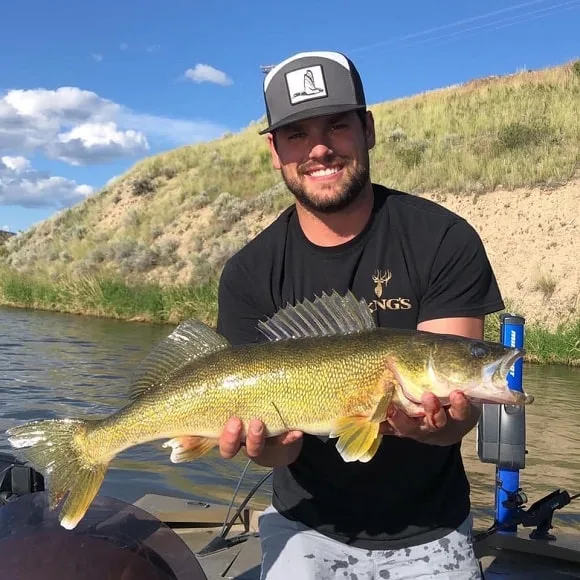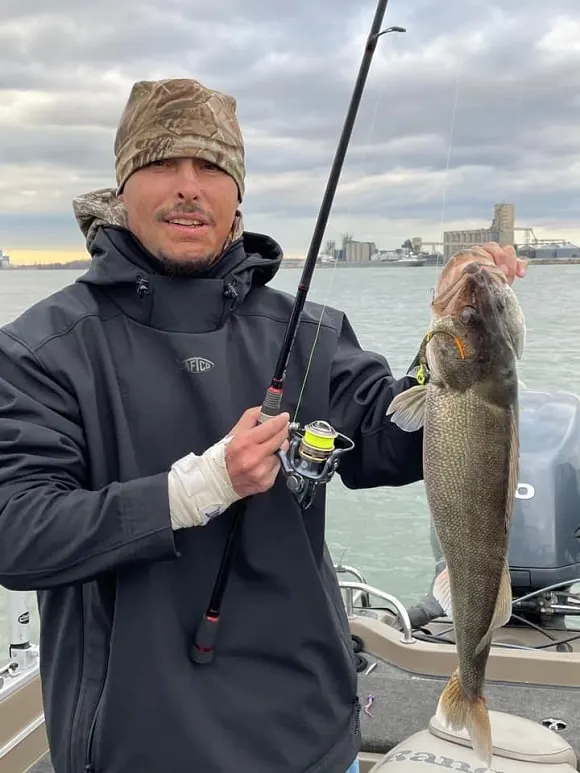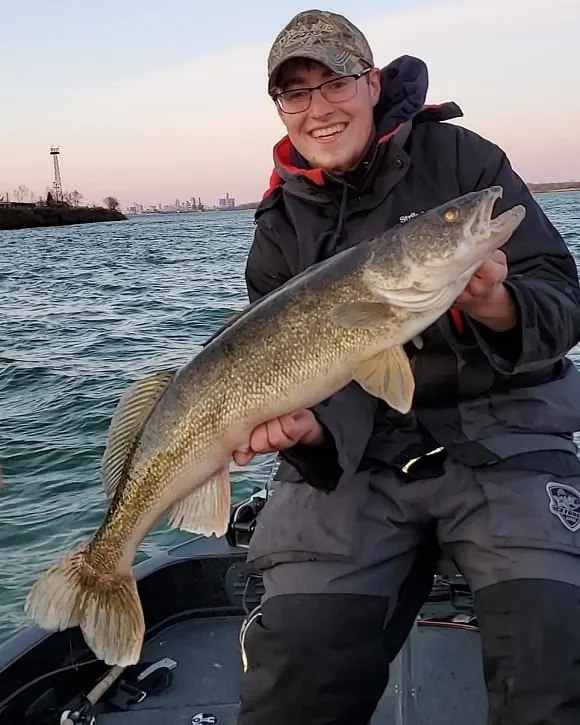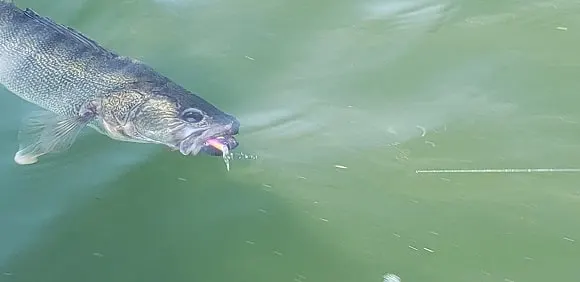All fish are affected by the weather, and walleyes are no exception here.
They can be pretty finicky if the weather doesn’t suit them, and fishing for them in such conditions can be challenging.
But just how much do different weather conditions really influence the walleye’s feeding behavior and activity, and is there an ultimate walleye weather?
The best weather conditions for walleye include moderate temperatures of 50 to 75°F, a stable barometric pressure, moderate winds, overcast days for clear water, and sunny days for dark water conditions.
If you want to catch more fish, keep reading and learn more about the most favorable weather conditions for walleye!
PRO TIP: Need new gear for the upcoming walleye season? Then check out this quality equipment on Amazon.
It’s very cost-effective, durable, and will get the job done every time!
Best Weather Conditions for Walleye

Walleye are fairly sensitive to changing weather conditions, which is why moderate temperatures and stable weather tends to yield the best result when fishing for this species.
Does that mean you can’t catch any eyes when there is a storm front on the way, when the barometric pressure is rapidly rising or falling, or when it’s super warm or cold? Not at all!
What it does mean, though, is that the bite can often be much better with the right weather conditions.
Some anglers don’t care about the weather and simply head out whenever they want to. And while that certainly works for some, others don’t have that luxury and only have few opportunities to go fishing.
If that’s the case, optimizing things and increasing your chances of catching fish is often essential! And one way of doing that is to prioritize days with the right weather conditions.
So what are the right conditions for walleye?
Temperature
Both air and water temperatures should be moderate for the best walleye fishing. If it’s too cold or hot, the fish will become inactive, and you’ll end up either freezing or melting.
The optimal water temperature range for walleye is between 50 and 75°F, meaning late spring or early summer to late summer or early fall.
This is a temperature range that most fish species find very agreeable, as there is plenty of food and oxygen in the water, making the fish both hungry and very active.
Of course, you can go as low as around 40 or as high as around 80°F in open water, but there is a big risk that the fishing will be fairly slow.
Barometric Pressure
This is an interesting one, and there are many debates surrounding this topic. Does barometric pressure affect walleye?
It does affect the fish, but only if there are sudden changes in pressure.
Much like bass or perch, the walleye’s swim bladder doesn’t connect to its stomach, which means that it can’t regulate changing air pressure as fast as other fish species.
And so, if the barometric pressure suddenly goes from high to low, or vice versa, or goes up and down over several days, the walleye will be busy adjusting their depth to adapt to the changing pressure.
During that time, they usually lose their appetite altogether.
Stable high or low-pressure systems, as well as slowly rising or falling barometric pressure, on the other hand, are very favorable conditions for walleye.
The slow change in pressure gives the fish enough time to adjust their swim bladder and allows them to keep hunting and feeding.
Wind
Wind intensity and direction can also affect your walleye fishing.
You obviously want to avoid fishing in strong winds, as casting, retrieving, and detecting bites can be difficult when its too windy and there are plenty of big waves on the lake.
On the contrary, a light to moderate breeze is always welcome when predator fishing, if you ask me!
A light wind breaks the surface and makes the water more stained, which usually means less careful walleye, as the visibility underwater is somewhat lower.
Consistent winds also push food (like plankton and algae) into shallower water. This attracts the baitfish into the area, which, in turn, attract the bigger predators. This is what walleye anglers commonly refer to as the “walleye chop“.
PRO TIP: Follow the wind and see if you can spot a cloud of baitfish somewhere in the shallows where the wind hits them. If you find the baits, you’ll find the walleyes!
Wind direction is a less important factor, even though I prefer fishing in warmer winds from the south, southwest, or southeast. But that’s more of a personal preference, I guess.
Sun and Clouds
These are two critical factors, and they can have completely opposite effects on your fishing, depending on whether you’re targeting clear or dark water.
Clear Water
Clear water lakes have very high visibility! The sun can penetrate even deeper water, and the walleye tend to hide behind or under heavy cover and seek out very deep water to keep away from the light.
That means that you should prioritize overcast days with little or no sunlight. The fish will be much more active and less careful in such conditions.
Additionally, they won’t feel the need to go as deep, which means that you can even target the shallower areas of the lake when it’s cloudy.
Stained Water
In dark or stained water, the opposite holds true! Here, you will actually want some sunlight when fishing for walleye!
Why? Because walleyes are sight feeders that rely heavily on their eyes, and if it’s too muddy or dark underwater, they simply won’t be able to hunt efficiently.
In such waterbodies, the fish need the day and direct sunlight to find their prey, which is why sunny days are advantageous for stained water walleye.
You don’t have to worry about the light increasing the visibility underwater! That’s not a concern here. Instead, the sun gives the walleye just enough visibility to hunt but not enough for them to feel the need to find cover.
So if you are fishing for murky water walleye, head out on those pleasant sunny days! Especially if there is no wind, as this will allow even more light to penetrate the water surface.
RELATED ARTICLE: How to Catch More Walleye in Muddy Water?
Does Rain Affect Walleye Fishing?

Light rain is usually favorable when walleye fishing, because that means clouds, decreased visibility, and more oxygen in the water.
This makes the most sense in clear water; thanks to the increased turbidity, the fish will often roam the shallows, as there are plenty of baitfish around.
But the increased oxygen levels and movement in the water is also highly favorable in lakes with stained water.
Additionally, I have found that the fish will stay active long after a rainfall, as the water will remain to be well oxygenated and the baitfish are plentiful in the shallows.
This creates the ultimate opportunity for the walleye, which will often fall enter a feeding frenzy.
So, by all means, get fishing when there is a drizzle out there! Just don’t forget your rain gear!
Heavy and persistent rain, on the other hand, tends to turn off the bite completely, as this usually means a rapidly falling barometric pressure and colder air coming in.
It’s also really not pleasant to be outside when bad weather like that hits you.
RELATED ARTICLE: What Is the Best Landing Net for Walleye?
Do Walleye Bite in Cold Weather?

While walleye undoubtedly feed in water temperatures well below 50°F, really cold weather tends to turn them off.
Obviously, they won’t stop feeding entirely; just look at how well they usually bite during ice season. But days or periods with really low temperatures during early spring and late fall can be extremely difficult.
Fishing in open water on chilly days with icy winds isn’t much fun. Trust me; I’ve been there too many times myself.
But if you still decide to head out during that really cold weather, head for the deepest areas of the lake or river you’re fishing on! That’s where the walleye will hold up. (That holds true for the ice season as well, by the way)
Deeper water is warmer, and the walleyes usually group up down there when the weather is too cold.
Additionally, the baitfish will also be drawn to these areas. So if you can find the baitfish, there is a good chance that you’ll even find actively feeding walleye. Just be ready for relatively short feeding windows!
But remember this: it’s perfectly okay to sit out those chilly days and wait for warmer weather! A nice and humid warm front between these periods of cold weather can improve things and turn the fish on fast.
So if you, like me, enjoy warmer weather and not freezing your fingers off, you’ll wait for that weather change to chase those eyes!
Do Walleye Bite in Hot Weather?

All that’s left to discuss now is hot weather conditions. Walleyes are fish best caught in summer, but do they like really high temperatures?
To a certain point, yes, and I would say that point is a water temperature of 80°F. That’s pretty much where the comfort zone for many predatory freshwater fish ends!
Warmer water contains a lot less oxygen, slowing the fish down and making them fairly inactive during the daytime.
So if you want to head out during the dog days of summer, here are a few tips for you.
- Avoid fishing during midday, when the temperatures are highest. If you manage to catch anything at all, the bite will be super slow. Instead, fish early mornings and late evenings, when the sun and temperature are lower.
- Target the deepest areas in your lake! That deep water will be cooler during summer, as the sun can’t reach the lower water columns. That’s where you will find those high summer eyes!
- If it’s too hot, avoid going fishing altogether and wait for days with more moderate temperatures. If it’s too hot for comfort for you, it’s the same for the fish. Let them rest and catch them later!
PRO TIP: Now more than ever, a weather change can turn the fish on in no time flat! If there is a summer storm front on the way, get fishing before it arrives or after it has moved on! There is a good chance of feeding frenzies!
Essential Gear Tips
If you’re looking for solid and reliable walleye fishing gear, these tips might be useful for you.
This gear and tackle is of top quality and sells at a very decent price on Amazon:
Ugly Stik GX2 Medium 6’6” Spinning Rod
A solid and popular all-round spinning rod! The Ulgy Stick is lightweight, has great sensitivity, and phenomenal action. Fits both beginners and seasoned anglers. A 6’6” or 7′ Medium rod is your best pick for walleyes.
Pflueger President 30 Spinning Reel
An affordable high-performance spinning reel that’s perfect for walleye. Pflueger spells high quality and awesome durability! Makes for a great combo together with Ugly Stick. A Size 30 or 35 is a solid choice for walleye!
One of the best braids available today! Zero stretch, great feel, and immense strength make this line the perfect pick for walleye in both open and snaggy waters. Put on a 10 to 20 lb test, and you’re good to go!
Related Articles
- Best Clear Water Walleye Fishing Tactics
- What Is the Best Fishing Line for Walleye?
- What Time of Year Do Walleye Spawn?
Featured image courtesy of Nick Penner

